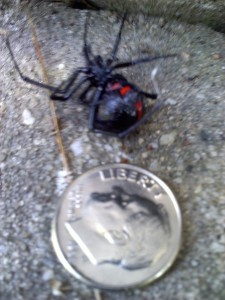While most of the creatures around Cragrock are benign, there are a few to watch out for. This article deals with dangerous insects on the Cumberland Plateau and how to avoid them. Before you slather yourself in DDT, keep in mind that fewer than one percent of the insects on the earth are harmful to humans and the vast majority of insects that you will encounter while trekking around Sparta can’t even bite; those that do bite cause only temporary pain – – unless of course you are allergic. More important, many of the insects that you encounter are beneficial to the environment – – dangerous or not.
I have seen more Latrodectus mactans in the last two years than I have seen in all the previous years of my life combined. When I mention this to other aging outdoor enthusiasts, they agree. For some reason, the black widow spider is on the rise. Black widows like warm dark environments and from what I’ve seen, seem to have an affinity for the underside of metal objects. Black widow venom is a neurotoxin, it is rarely fatal but can cause extreme illness.
In addition to black widows, we have brown recluse spiders in the area. If you do a web search for “brown recluse bite” keep in mind that the images that they show you are the worst-case-scenarios that they could find on the entire planet. I was bitten by a brown recluse and other than a little red swelling, experienced no ill effect. NINTY PERCENT of brown recluse bites go undetected. I sometimes wonder if we are doing more damage to ourselves by prophylactically treating our homes with copious amounts of chemicals trying to cure arachnophobia, than we would cause if we simply let the fangs land where they may.
Perhaps the most dangerous insect that I’ve personally encountered, may be as small as the period following this sentence, yet it can prove fatal and they are abundant in the southeast. Like spiders, they are arachnids; unlike spiders, you never feel their bite. For every poisonous spider that I’ve encountered, I’ve probably seen at least one-hundred of these eight-legged creatures – – they are that common.
During the weeks, months, and years following the bite of these insects people have been misdiagnosed with everything from Arthritis to Alzheimer’s Disease. Understand that ticks don’t have venom, but they carry a host of diseases and many go undiagnosed in humans. I was fortunate to be teaching at a research one university when I became ill from a tick bite. It was early in the 90s, lyme disease had been in the news enough, and I was outdoors enough, that every time I found an imbedded tick, I taped it inside my day-timer – – just-in-case. Six weeks following the removal of an embedded tick, I felt just like I had the flu, except I had no respiratory symptoms. With a fever of 101 for three days, I finally caved and went to the Vanderbilt Clinic after my spleen was so swollen that I had to sleep with a pillow under me to level my girth.
The doctor I visited had spent time as a missionary in Africa. When I described the symptoms, she was puzzled until I said “and by the way, I found this tick attached to me about six weeks ago”. Then I quickly added “but I never had a bulls-eye rash”. She asked if I had been in the proximity of Fairfield Glade near Crossville. When I said yes, she exclaimed “Human Granulocytic Ehrlichiosis, bend over”! After giving me a shot of doxycycline, she went on to explain that there had been an outbreak of HGE at Fairfield a few years before. Twenty-five percent of the residents of Fairfield had tested positive for HGE, and that there was even a statistical correlation of high golf scores, and incidence. She then added that the US was just learning what doctors practicing in Africa had known for years. Ticks can deliver a multitude of diseases, some are yet to be named, but most of them can be treated with doxycycline. She went on to tell me only a few lucky people have a reaction and get a rash from a tick bite; many of the others never seek treatment and let the spirochete wreak havoc. Eventually the spirochete can penetrate every organ of the body – – including the brain and heart. Later, people who have been labeled Alzheimer’s, arthritis, etc. pass on, never knowing that a tick had caused them decades of grief.
 DEET, is the most popular tick repellent. Keep in mind that studies have shown the percentage of DEET must exceed 27% to repel some tick species. And, the most common cause of anaphylaxis in the United States is not from insect bites, it is from unsuspecting souls standing downwind of another person applying DEET. If that’s not enough to scare you away from DEET, DEET was implicated in Gulf War Syndrome.
DEET, is the most popular tick repellent. Keep in mind that studies have shown the percentage of DEET must exceed 27% to repel some tick species. And, the most common cause of anaphylaxis in the United States is not from insect bites, it is from unsuspecting souls standing downwind of another person applying DEET. If that’s not enough to scare you away from DEET, DEET was implicated in Gulf War Syndrome.
I started this epistle recommending that you avoid putting pesticides on your skin. I will end it by stating that the most effective tick repellent that I have found contains permethrin. You don’t apply permethrin to your skin, you let it dry on outdoor wear and it remains effective for over a half-dozen washings. Not only does it repel ticks, it kills them. I have found a few dead ticks on my floor after I return from hours in the woods. What will the long-term effect of permethrin be on ME? I don’t know, but I can tell you what the short-term effect of a tick bite was and it wasn’t pleasant. Some studies indicate that one in four ticks carry diseases that can infect humans. As much as I enjoy the outdoors, I’ll risk the permethrin. I have pulled zero ticks out of my skin since I have been using this daisy-derived product. My favorite brand is made by Coleman.
And just when you thought it was safe to go back into the woods . . . . .
[mashshare]

